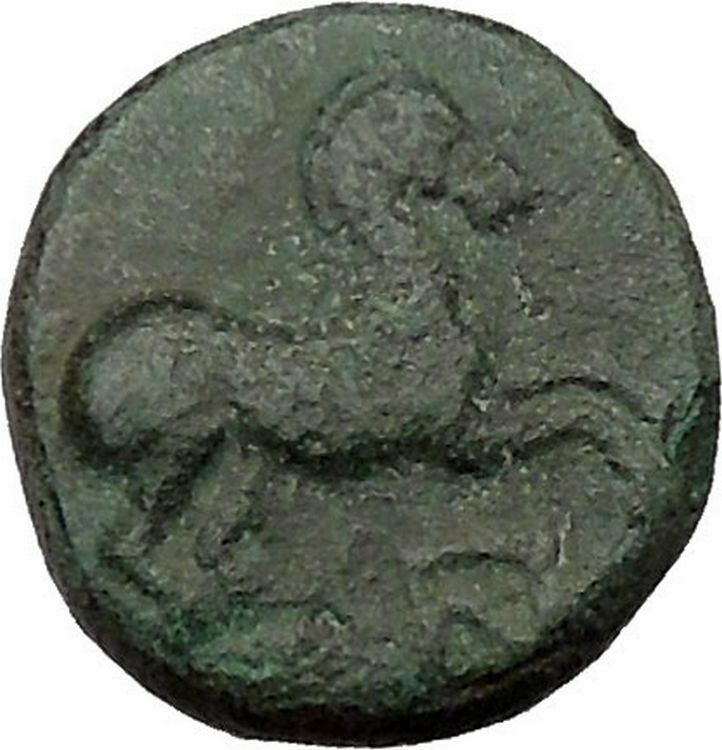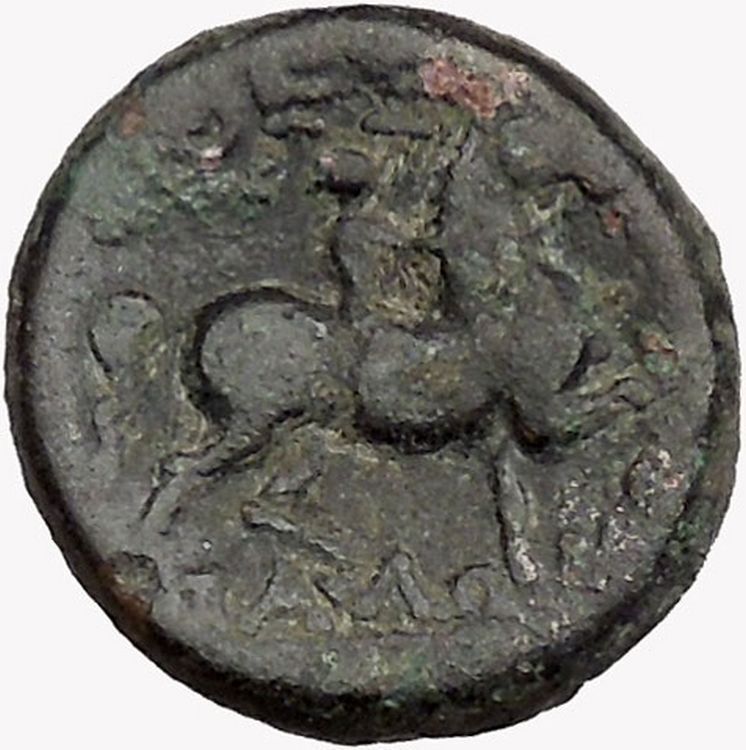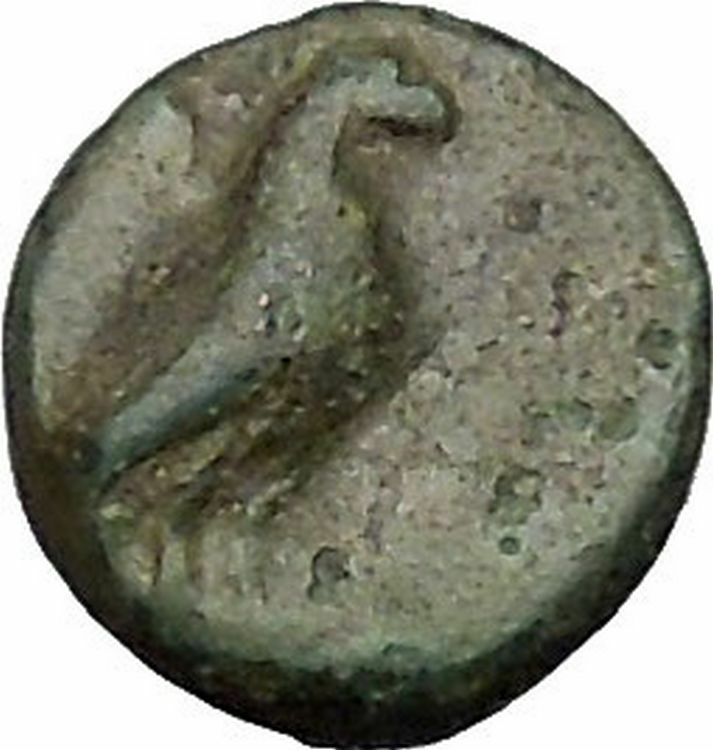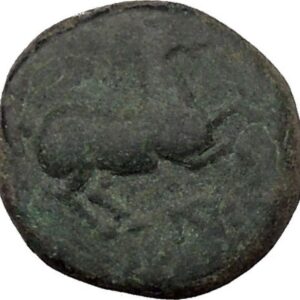|
Greek city of
Pantikapaion
in
Tauric Chersonesos
Bronze 18mm (2.91 grams) Struck circa 3rd-2nd Century B.C.
Reference: Sear 1705; B.M.C.3.39,40
Bearded head of
Pan
left, wreathed with ivy.
ΠANTI,
Cornucopia
between caps of the
Dioscuri
.
You are bidding on the exact item pictured,
provided with a Certificate of Authenticity and Lifetime Guarantee of
Authenticity.
The cornucopia (from Latin cornu copiae) or horn of plenty
is a symbol of abundance and nourishment, commonly a large horn-shaped container
overflowing with produce, flowers, nuts, other edibles, or wealth in some form.
Originating in
classical antiquity
, it has continued as a
symbol in
Western art
, and it is particularly associated
with the
Thanksgiving
holiday in
North America
.

Allegorical
depiction of the Roman
goddess
Abundantia
with a cornucopia, by
Rubens
(ca. 1630)
In Mythology
Mythology
offers multiple
explanations of the origin
of the cornucopia.
One of the best-known involves the birth and nurturance of the infant
Zeus, who had to be hidden from his devouring father
Cronus
. In a cave on
Mount Ida
on the island of
Crete
, baby Zeus was cared for and protected by
a number of divine attendants, including the goat
Amalthea
(“Nourishing Goddess”), who fed him
with her milk. The suckling future king of the gods had unusual abilities and
strength, and in playing with his nursemaid accidentally broke off one of her
horns
, which then had the divine power to
provide unending nourishment, as the foster mother had to the god.
In another myth, the cornucopia was created when
Heracles
(Roman
Hercules
) wrestled with the river god
Achelous
and wrenched off one of his horns;
river gods were sometimes depicted as horned. This version is represented in the
Achelous and Hercules
mural painting
by the
American Regionalist
artist
Thomas Hart Benton
.
The cornucopia became the attribute of several
Greek
and
Roman deities
, particularly those associated
with the harvest, prosperity, or spiritual abundance, such as personifications
of Earth (Gaia
or
Terra
); the child
Plutus
, god of riches and son of the grain
goddess Demeter
; the
nymph
Maia
; and
Fortuna
, the goddess of luck, who had the power
to grant prosperity. In
Roman Imperial cult
, abstract Roman deities who
fostered peace (pax
Romana) and prosperity were also depicted with a cornucopia,
including Abundantia
, “Abundance” personified, and
Annona
, goddess of the
grain supply to the city of Rome
.
Pluto
, the classical ruler of the underworld in
the
mystery religions
, was a giver of agricultural,
mineral and spiritual wealth, and in art often holds a cornucopia to distinguish
him from the gloomier Hades
, who holds a
drinking horn
instead.
Modern depictions
In modern depictions, the cornucopia is typically a hollow, horn-shaped
wicker basket filled with various kinds of festive
fruit
and
vegetables
. In North America, the cornucopia
has come to be associated with
Thanksgiving
and the harvest. Cornucopia is
also the name of the annual November Wine and Food celebration in
Whistler
, British Columbia, Canada. Two
cornucopias are seen in the
flag
and
state seal
of
Idaho
. The Great
Seal
of
North Carolina
depicts Liberty standing and
Plenty holding a cornucopia. The coat of arms of
Colombia
,
Panama
,
Peru and
Venezuela
, and the Coat of Arms of the State of
Victoria, Australia
, also feature the
cornucopia, symbolising prosperity.
The horn of plenty is used on body art and at Halloween, as it is a symbol of
fertility, fortune and abundance.
-
Base of a statue of
Louis XV of France
In
Greek religion
and
mythology
, Pan (Ancient
Greek: Πᾶν, Pān) is the
god of the wild, shepherds and flocks, nature of mountain wilds, hunting and
rustic music
, and companion of the
nymphs
.[1]
His name originates within the
Ancient Greek
language, from the word paein
(πάειν), meaning “to pasture.”[2]
He has the hindquarters, legs, and horns of a goat, in the same manner as a
faun or satyr
. With his homeland in rustic
Arcadia
, he is recognized as the god of fields,
groves, and wooded glens; because of this, Pan is connected to fertility and the
season of spring. The ancient Greeks also considered Pan to be the god of
theatrical criticism.

The god Pan is said to have intervened on behalf of the
Macedonians in Antiogonos’ battle
with the Gauls in 277 B.C.
In
Roman religion and myth
, Pan’s counterpart was
Faunus
, a nature god who was the father of
Bona Dea
, sometimes identified as
Fauna
. In the 18th and 19th centuries, Pan
became a significant figure in
the Romantic movement
of western Europe, and
also in the 20th-century
Neopagan movement
.
Origins
In his earliest appearance in literature,
Pindar
‘s Pythian Ode iii. 78, Pan is associated
with a
mother goddess
, perhaps
Rhea
or
Cybele
; Pindar refers to virgins worshipping
Cybele
and Pan near the poet’s house in
Boeotia
.
The parentage of Pan is unclear; in some
myths
he is the son of
Zeus, though generally he is the son of
Hermes
or
Dionysus
, with whom his mother is said to be a
nymph
, sometimes
Dryope
or, in
Nonnus
, Dionysiaca (14.92), Penelope of
Mantineia
in Arcadia. This nymph at some point
in the tradition became conflated with
Penelope
, the wife of
Odysseus
.
Pausanias
8.12.5 records the story that
Penelope had in fact been unfaithful to her husband, who banished her to
Mantineia upon his return. Other sources (Duris
of Samos; the Vergilian commentator
Servius
) report that Penelope slept with all
108 suitors in Odysseus’ absence, and gave birth to Pan as a result. This myth
reflects the folk etymology that equates Pan’s name (Πάν) with the Greek word
for “all” (πᾶν). It is more likely to be
cognate
with paein, “to pasture”, and to
share an origin with the modern English word “pasture”. In 1924, Hermann Collitz
suggested that Greek Pan and Indic
Pushan
might have a common Indo-European
origin. In the
Mystery cults
of the highly syncretic
Hellenistic
era Pan is made cognate with
Phanes/Protogonos
,
Zeus,
Dionysus
and
Eros
.
The
Roman
Faunus
, a god of Indo-European origin, was
equated with Pan. However, accounts of Pan’s genealogy are so varied that it
must lie buried deep in mythic time. Like other nature spirits, Pan appears to
be older than the
Olympians
, if it is true that he gave
Artemis
her hunting dogs and taught the secret
of prophecy to Apollo
. Pan might be multiplied as the Panes
(Burkert 1985, III.3.2; Ruck and Staples 1994 p 132) or the Paniskoi.
Kerenyi (p. 174) notes from
scholia
that
Aeschylus
in Rhesus distinguished
between two Pans, one the son of Zeus and twin of
Arcas
, and one a son of
Cronus
. “In the retinue of
Dionysos
, or in depictions of wild landscapes,
there appeared not only a great Pan, but also little Pans, Paniskoi, who played
the same part as the Satyrs
“.
Worship
The worship of Pan began in
Arcadia
which was always the principal seat of
his worship. Arcadia was a district of mountain people whom other Greeks
disdained. Greek hunters used to scourge the statue of the god if they had been
disappointed in the chase (Theocritus. vii. 107). Being a rustic god, Pan was
not worshipped in temples or other built edifices, but in natural settings,
usually caves
or
grottoes
such as the one on the north slope of
the
Acropolis of Athens
. These are often referred
to as the Cave of Pan
. The only exceptions are the
Temple of Pan
on the
Neda River
gorge in the southwestern
Peloponnese
– the ruins of which survive to
this day – and the Temple of Pan at
Apollonopolis Magna in
ancient Egypt
.
Mythology
Greek deities
series |
|
Primordial deities
|
Titans
and
Olympians
|
|
Aquatic deities
|
|
Chthonic deities
|
|
Personified concepts
|
| Other deities |
- Anemoi
-
Asclepius
-
Iris
- Leto
|
|
The goat-god Aegipan
was nurtured by
Amalthea
with the infant
Zeus in Athens. In Zeus’ battle with
Gaia
, Aegipan and
Hermes
stole back Zeus’ “sinews” that
Typhon
had hidden away in the
Corycian Cave
. Pan aided his foster-brother in
the battle with the Titans
by letting out a
horrible screech and scattering them in terror. According to some traditions,
Aegipan
was the son of Pan, rather than his
father.
One of the famous myths of Pan involves the origin of his
pan flute
, fashioned from lengths of hollow
reed. Syrinx
was a lovely water-nymph
of Arcadia, daughter of Landon, the river-god. As she was returning from the
hunt one day, Pan met her. To escape from his importunities, the fair nymph ran
away and didn’t stop to hear his compliments. He pursued from Mount Lycaeum
until she came to her sisters who immediately changed her into a reed. When the
air blew through the reeds, it produced a plaintive melody. The god, still
infatuated, took some of the reeds, because he could not identify which reed she
became, and cut seven pieces (or according to some versions, nine), joined them
side by side in gradually decreasing lengths, and formed the musical instrument
bearing the name of his beloved
Syrinx
. Henceforth Pan was seldom seen without
it.
Echo
was a nymph who was a great singer and
dancer and scorned the love of any man. This angered Pan, a
lecherous god, and he instructed his followers to kill her. Echo was
torn to pieces and spread all over earth. The goddess of the earth,
Gaia
, received the pieces of Echo, whose voice
remains repeating the last words of others. In some versions, Echo and Pan had
two children: Iambe
and
Iynx. In other versions, Pan had fallen in love with Echo, but she
scorned the love of any man but was enraptured by Narcissus. As Echo was cursed
by Hera to only be able to repeat words that had been said by someone else, she
could not speak for herself. She followed Narcissus to a pool, where he fell in
love with his own reflection and changed into a narcissus flower. Echo wasted
away, but her voice could still be heard in caves and other such similar places.
Pan also loved a nymph named
Pitys
, who was turned into a pine tree to
escape him.
Disturbed in his secluded afternoon naps, Pan’s angry shout inspired
panic
(panikon deima) in lonely
placesFollowing the Titans’ assault on
Olympus
, Pan claimed credit for the victory of
the gods because he had frightened the attackers. In the
Battle of Marathon
(490 BC), it is said that
Pan favored the Athenians and so inspired panic in the hearts of their enemies,
the Persians
Erotic aspects

Pan with a goat, statue from
Villa of the Papyri
,
Herculaneum
.
Pan is famous for his sexual powers, and is often depicted with a
phallus
.
Diogenes of Sinope
, speaking in jest, related a
myth of Pan learning
masturbation
from his father,
Hermes
, and teaching the habit to shepherds.
Pan’s greatest conquest was that of the moon goddess
Selene
. He accomplished this by wrapping
himself in a
sheepskin
to hide his hairy black goat form,
and drew her down from the sky into the forest where he seduced her.
Pan and music
In two late Roman sources,
Hyginus
and
Ovid, Pan is substituted for the satyr
Marsyas
in the theme of a musical competition (agon),
and the punishment by flaying is omitted.
Pan once had the audacity to compare his music with that of
Apollo
, and to challenge Apollo, the god of the
lyre, to a trial of skill.
Tmolus
, the mountain-god, was chosen to umpire.
Pan blew on his pipes and gave great satisfaction with his rustic melody to
himself and to his faithful follower,
Midas
, who happened to be present. Then Apollo
struck the strings of his lyre. Tmolus at once awarded the victory to Apollo,
and all but Midas agreed with the judgment. Midas dissented and questioned the
justice of the award. Apollo would not suffer such a depraved pair of ears any
longer and turned Midas’ ears into those of a
donkey
.
In another version of the myth, the first round of the contest was a tie, so
the competitors were forced to hold a second round. In this round, Apollo
demanded that they play their instruments upside-down. Apollo, playing the lyre,
was unaffected. However, Pan’s pipe could not be played while upside down, so
Apollo won the contest.
Capricornus
The
constellation
Capricornus
is traditionally depicted as a
sea-goat, a goat with a fish’s tail (see
“Goatlike” Aigaion called Briareos, one of the
Hecatonchires
). A myth reported as “Egyptian” in
Gaius Julius Hyginus
‘ Poetic Astronomy[22]
that would seem to be invented to justify a connection of Pan with Capricorn
says that when Aegipan
— that is Pan in his goat-god aspect —
was attacked by the monster
Typhon
, he dove into the Nile; the parts above
the water remained a goat, but those under the water transformed into a fish.
Epithets
Aegocerus “goat-horned” was an epithet of Pan descriptive of his
figure with the horns of a goat.
All of the Pans
Pan could be multiplied into a swarm of Pans, and even be given individual
names, as in Nonnus
‘
Dionysiaca
, where the god Pan had twelve
sons that helped Dionysus in his war against the Indians. Their names were
Kelaineus, Argennon, Aigikoros, Eugeneios, Omester, Daphoineus, Phobos,
Philamnos, Xanthos, Glaukos, Argos, and Phorbas.
Two other Pans were
Agreus
and
Nomios
. Both were the sons of Hermes, Agreus’
mother being the nymph Sose, a prophetess: he inherited his mother’s gift of
prophecy, and was also a skilled hunter. Nomios’ mother was Penelope (not the
same as the wife of Odysseus). He was an excellent shepherd, seducer of nymphs,
and musician upon the shepherd’s pipes. Most of the mythological stories about
Pan are actually about Nomios, not the god Pan. Although, Agreus and Nomios
could have been two different aspects of the prime Pan, reflecting his dual
nature as both a wise prophet and a lustful beast.
Aegipan
, literally “goat-Pan,” was a Pan who
was fully goatlike, rather than half-goat and half-man. When the Olympians fled
from the monstrous giant Typhoeus and hid themselves in animal form, Aegipan
assumed the form of a fish-tailed goat. Later he came to the aid of Zeus in his
battle with Typhoeus, by stealing back Zeus’ stolen sinews. As a reward the king
of the gods placed him amongst the stars as the Constellation Capricorn. The
mother of Aegipan, Aix (the goat), was perhaps associated with the constellation
Capra.
Sybarios was an Italian Pan who was worshipped in the Greek colony of Sybaris
in Italy. The Sybarite Pan was conceived when a Sybarite shepherd boy named
Krathis copulated with a pretty she-goat amongst his herds.
The “Death” of Pan
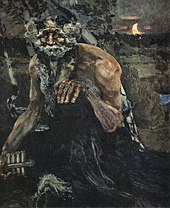
Pan,
Mikhail Vrubel
1900.
According to the Greek historian
Plutarch
(in De defectu oraculorum, “The
Obsolescence of Oracles”), Pan is the only Greek god (other than
Asclepius
) who actually dies. During the reign
of Tiberius
(A.D. 14–37), the news of Pan’s death
came to one Thamus, a sailor on his way to Italy by way of the island of
Paxi. A divine voice hailed him across the salt water, “Thamus, are
you there? When you reach
Palodes
, take care to proclaim that the great
god Pan is dead.” Which Thamus did, and the news was greeted from shore with
groans and laments.
Christian apologists took Plutarch’s notice to heart, and repeated and
amplified it until the 18th century. It was interpreted with
concurrent meanings
exegesisin all four modes of medieval
: literally as historical fact, and
allegorically
as the death of the ancient order
at the coming of the new.[original
research?]
Eusebius of Caesarea
in his
Praeparatio Evangelica
(book V) seems to
have been the first Christian apologist to give Plutarch’s anecdote, which he
identifies as his source pseudo-historical standing, which Eusebius buttressed
with many invented passing details that lent
verisimilitude
. It should be noted that it
would be absurd for medieval Christian apologists to even consider Plutarch’s
account to be historically factual–and not merely a symbolic anecdote–inasmuch
as their Christian monotheistic beliefs would inevitably come into conflict with
Plutarch’s pagan polytheistic account.
In more modern times, some have suggested a possible a naturalistic explanation
for the myth. For example,
Robert Graves
(The Greek Myths) reported
a suggestion that had been made by Salomon Reinach and expanded by James S. Van
Teslaar[29]
that the hearers aboard the ship, including a supposed Egyptian, Thamus,
apparently misheard Thamus Panmegas tethneke ‘the all-great
Tammuz
is dead’ for ‘Thamus, Great Pan is
dead!’, Thamous, Pan ho megas tethneke. “In its true form the phrase
would have probably carried no meaning to those on board who must have been
unfamiliar with the worship of Tammuz which was a transplanted, and for those
parts, therefore, an exotic custom.” Certainly, when
Pausanias
toured Greece about a century after
Plutarch, he found Pan’s shrines, sacred caves and sacred mountains still very
much frequented. However, a naturalistic explanation might not be needed. For
example, William Hansen has shown that the story is quite similar to a class of
widely-known tales known as Fairies Send a Message.
The cry “Great Pan is dead” has appealed to poets, such as
John Milton
, in his ecstatic celebration of
Christian peace,
On the Morning of Christ’s Nativity
line
89, and
Elizabeth Barrett Browning
.
One remarkable commentary of Herodotus on Pan is that he lived 800 years
before himself (c. 1200 BCE), this being already after the Trojan War.
Influence
Revivalist imagery

The Magic of Pan’s Flute, by
John Reinhard Weguelin
(1905)
In the late 18th century, interest in Pan revived among liberal scholars.
Richard Payne Knight
discussed Pan in his
Discourse on the Worship of Priapus (1786) as a symbol of creation expressed
through sexuality. “Pan is represented pouring water upon the organ of
generation; that is, invigorating the active creative power by the prolific
element.”
In the English town of
Painswick
in
Gloucestershire
, a group of 18th century
gentry, led by Benjamin Hyett, organised an annual procession dedicated to Pan,
during which a statue of the deity was held aloft, and people shouted ‘Highgates!
Highgates!” Hyett also erected temples and follies to Pan in the gardens of his
house and a “Pan’s lodge”, located over Painswick Valley. The tradition died out
in the 1830s, but was revived in 1885 by the new vicar, W. H. Seddon, who
mistakenly believed that the festival had been ancient in origin. One of
Seddon’s successors, however, was less appreciative of the pagan festival and
put an end to it in 1950, when he had Pan’s statue buried.
John Keats
‘s
“Endymion”
opens with a festival dedicated to
Pan where a stanzaic hymn is sung in praise of him. “Keats’s account of Pan’s
activities is largely drawn from the Elizabethan poets. Douglas Bush notes, ‘The
goat-god, the tutelary divinity of shepherds, had long been allegorized on
various levels, from Christ to “Universall Nature”
(Sandys)
; here he becomes the symbol of the
romantic imagination, of supra-mortal knowledge.'”
In the late nineteenth century Pan became an increasingly common figure in
literature and art. Patricia Merivale states that between 1890 and 1926 there
was an “astonishing resurgence of interest in the Pan motif”. He appears in
poetry, in novels and children’s books, and is referenced in the name of the
character Peter Pan
. He is the eponymous “Piper at the
Gates of Dawn” in the seventh chapter of
Kenneth Grahame
‘s
The Wind in the Willows
(1908). Grahame’s
Pan, unnamed but clearly recognisable, is a powerful but secretive nature-god,
protector of animals, who casts a spell of forgetfulness on all those he helps.
He makes a brief appearance to help the Rat and Mole recover the Otter’s lost
son Portly.
Arthur Machen
‘s 1894 novella
The Great God Pan
uses the god’s name in a
simile about the whole world being revealed as it really is: “. . . seeing the
Great God Pan”. The novella is considered by many (including
Stephen King
) as being one of the greatest
horror stories ever written.
Pan entices villagers to listen to his pipes as if in a trance in
Lord Dunsany
‘s novel ‘The Blessing of Pan’
published in 1927. Although the god does not appear within the story, his energy
certainly invokes the younger folk of the village to revel in the summer
twilight, and the vicar of the village is the only person worried about the
revival of worship for the old pagan god.
Pan is also featured as a prominent character in
Tom Robbins
‘
Jitterbug Perfume
(1984).
Aeronautical engineer
and
occultist
Jack Parsons
invoked Pan before test launches
at the
Jet Propulsion Laboratory
.
Identification with
Satan
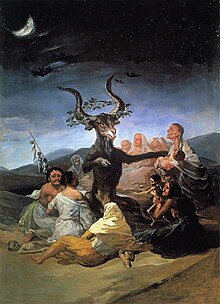
Francisco Goya
,
Witches’ Sabbath (El aquelarre),
. 1798. Oil on canvas, 44 × 31 cm. Museo Lázaro Galdiano, Madrid.
Pan’s goatish image recalls conventional
faun-like depictions of
Satan
. Although Christian use of Plutarch’s
story is of long standing[original
research?][citation
needed],
Ronald Hutton
has argued that this specific
association is modern and derives from Pan’s popularity in Victorian and
Edwardian
neopaganism
. Medieval and early modern images
of Satan tend, by contrast, to show generic semi-human monsters with horns,
wings and clawed feet.
Neopaganism
In 1933, the Egyptologist
Margaret Murray
published the book, The God
of the Witches, in which she theorised that Pan was merely one form of a
horned god
who was worshipped across Europe by
a
witch-cult
. This theory influenced the
Neopagan
notion of the Horned God, as an
archetype
of male virility and sexuality. In
Wicca
, the archetype of the Horned God is
highly important, as represented by such deities as the Celtic
Cernunnos
, Indian
Pashupati
and Greek Pan.
A modern account of several purported meetings with Pan is given by
Robert Ogilvie Crombie
in The Findhorn
Garden (Harper & Row, 1975) and The Magic Of Findhorn (Harper & Row,
1975). Crombie claimed to have met Pan many times at various locations in
Scotland, including
Edinburgh
, on the island of
Iona and at the
Findhorn Foundation
.
In classical mythology, Syrinx was a
nymph
and a follower of
Artemis
, known for her
chastity
. Pursued by the amorous Greek god
Pan
, she ran to a river’s edge and asked for
assistance from the river nymphs. In answer, she was transformed into hollow
water reeds
that made a haunting sound when the god’s
frustrated breath blew across them. Pan cut the reeds to fashion the first set
of
pan pipes
, which were thenceforth known as
syrinx. The word syringe was derived from this word.
In literature
The story of the syrinx is told in
Achilles Tatius
‘
Leukippe and Kleitophon
where the heroine
is subjected to a virginity test by entering a cave where Pan has left syrinx
pipes that will sound a melody if she passes. The story became popular among
artists and writers in the 19th century. The Victorian artist and poet
Thomas Woolner
wrote Silenus, a long
narrative poem about the myth, in which Syrinx becomes the lover of
Silenus
, but drowns when she attempts to escape
rape by Pan, as a result of the crime Pan is transmuted into a demon figure and
Silenus becomes a drunkard.
Amy Clampitt
‘s poem Syrinx refers to the
myth by relating the whispering of the reeds to the difficulties of language.
The story was used as a central theme by Aifric Mac Aodha in her poetry
collection “Gabháil Syrinx”.
Samuel R. Delany
features an instrument called
a syrynx in his classic science-fiction novel Nova.
In art

“Pan and Syrinx” by
Jean-François de Troy
The Victorian artist,
Arthur Hacker
(September 25, 1858 – November
12, 1919), depicted Syrinx in his 1892 nude. This painting in oil on canvas is
currently on display in
Manchester Art Gallery
.
Sculptor
Adolph Wolter
was commissioned in 1973 to
create a replacement for a stolen sculpture of
Syrinx
in
Indianapolis
,
Indiana
. This work was a replacement for a
similar statue by
Myra Reynolds Richards
that had been stolen.
The sculpture sits in University Park located in the city’s
Indiana World War Memorial Plaza
.
In music
Claude Debussy
wrote
“Syrinx (La Flute De Pan)”
based on Pan’s
sadness over losing his love. This piece was the first unaccompanied flute solo
of the 20th century[citation
needed], and remains a very popular addition to the
modern flautist’s repertoire. It was also transcribed for solo saxophone,
becoming a standard performance piece for saxophone too. It was used as
incidental music in the play Psyché by Gabriel Mourey.[4]
French Baroque composer Michel Pignolet de Montéclair composed “Pan et Syrinx”,
a cantata for voice & ensemble (No 4 of Second livre de cantates).
Danish composer
Carl Nielsen
composed “Pan
and Syrinx” (Pan og Syrinx), Op. 49, FS 87.
Canadian
electronic
progressive rock
band
Syrinx
took their name from the legend.
Canadian
progressive rock
band
Rush
have a movement titled “The Temples of
Syrinx” in their song “2112”
on their album
2112
. The song is about a
dystopian
futuristic society in which the arts,
particularly music, have been suppressed by the Priests of the Temples of Syrinx.
Panticapaeum (Greek:
Παντικάπαιον, Pantikápaion), present-day
Kerch
: an
important
Greek
city and port in Taurica
(Tauric Chersonese), situated on a hill (Mt.
Mithridates
) on the western side of the
Cimmerian Bosporus
, founded by
Milesians
in
the late 7th–early 6th century BC.
In the 5th–4th centuries BC, the city became the residence first of the
Archaeanactids
and then of the
Spartocids
,
dynasties of
Greek
kings of
Bosporus
, and was hence itself sometimes called Bosporus. Its economic
decline in the 4th–3rd centuries BC was the result of the
Sarmatian
conquest of the steppes and the growing competition of
Egyptian
grain. The last of the
Spartocids
,
Paerisades V
, apparently left his realm to
Mithridates VI
Eupator, king of
Pontus
.
This transition was arranged by one of Mithridates’s generals, a certain
Diophantus
, who earlier was sent to Taurica to help local Greek cities
against Palacus
of
Lesser Scythia
. The takeover didn’t go smoothly: Paerisades was murdered by
Scythians
led by
Saumacus
,
Diophantus
escaped to return later with reinforcements and to suppress the
revolt (c. 110 BC).
Half of a century later, Mithridates himself took his life in Panticapaeum,
when, after his defeat in a
war
against
Rome
,
his own son and heir
Pharnaces
and citizens of Panticapaeum turned against him. In 63 BC the city
was partly destroyed by an earthquake. Raids by the
Goths
and the
Huns furthered its
decline, and it was incorporated into the
Byzantine
state under
Justin I
in
the early 6th century AD.

Ruins of Panticapaeum in
Kerch
(Ukraine)
During the first centuries of the city’s existence, imported Greek articles
predominated: pottery
Kerch
Style), terracottas
, and metal objects, probably from workshops in
Rhodes
,
Corinth
,
Samos
,
and Athens
.
Local production, imitated from the models, was carried on at the same time.
Athens manufactured a special type of bowl for the city, known as
Kerch
ware. Local
potters imitated the
Hellenistic
bowls known as the
Gnathia
style as well as relief wares—Megarian
bowls. The city minted silver coins from the mid 6th century BC and from the 1st
century BC gold and bronze coins. The
Hermitage
and Kerch
Museums contain material from the site, which is still being
excavated.
Bibliography
-
Noonan, Thomas S.
“The Origins of the Greek Colony at Panticapaeum”,
American Journal of Archaeology, Vol. 77, No. 1. (1973), pp. 77–81.
|














